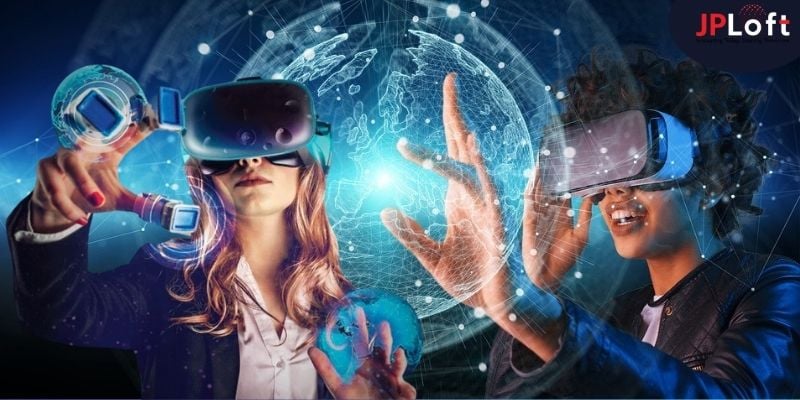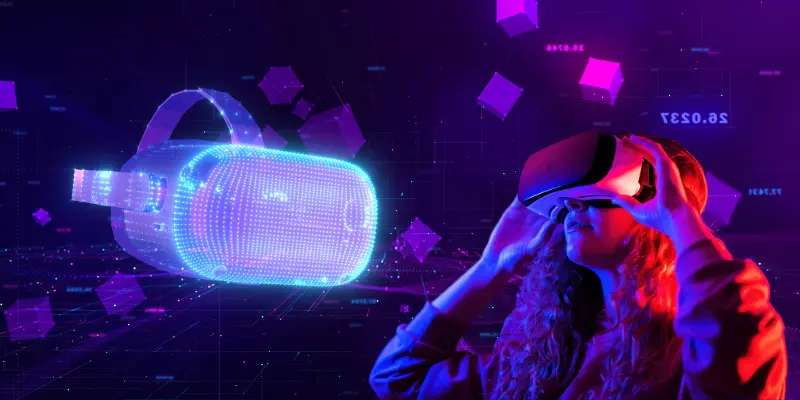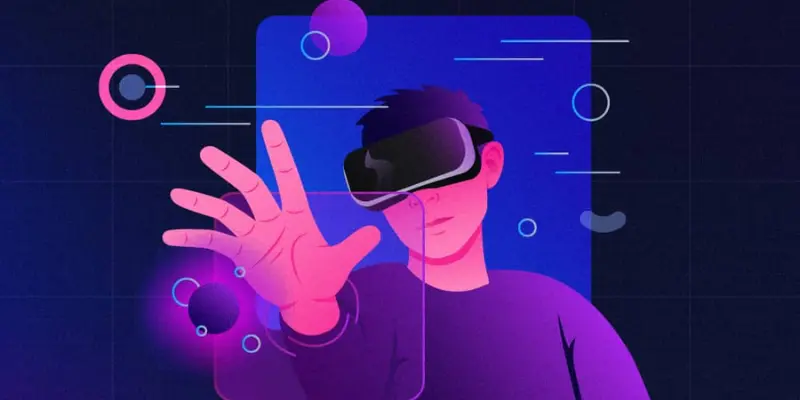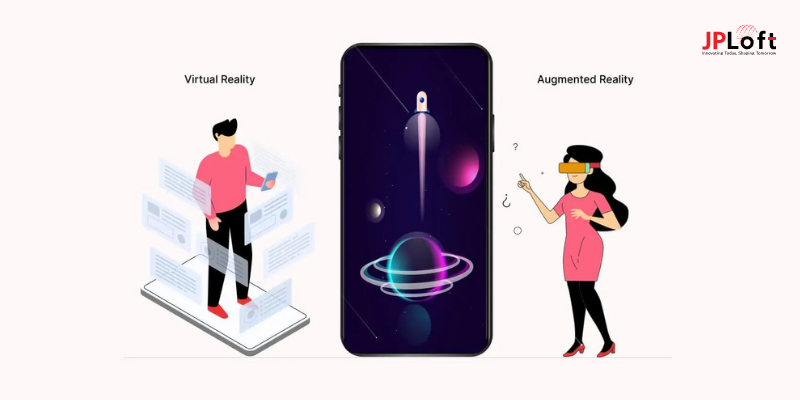Virtual reality and augmented reality were initially developed to aid gming however, their applications will likely prove popular across various sectors and fields by 2024, including health care.
Healthcare companies are quickly adapting their develop AR and VR technologies for better data analysis and medical procedures. Businesses have also introduced innovative ways of engaging patients during outbreaks by offering tailored care remotely; Virtual reality and augmented reality technologies may even enhance medical education or make patients better prepared for surgical procedures.
Virtual reality and augmented reality technologies have yet to make an impactful statement about healthcare and medicine globally, yet they are expected to become part of everyday healthcare and medicine practice over time. What will the next steps for these technologies look like? This article explores both their use in the healthcare market and possible applications.
Read About: AR VR Trends and Predictions In Upcoming Years
The distinction between VR and AR
Augmented Reality refers to enhancing the physical environment in a particular manner (think Google Glass). The technology projects digital data onto the existing environment, creating an impression of Reality. Virtual Reality allows for a complete experience through VR glasses that completely blinds the eyes. The VR glass completely blocks sounds outside, providing an entirely immersive experience.
Augmented Reality is distinct from VR. It is a virtual reality (VR) form that creates a virtual world that totally disconnects users from the real world. AR is distinctive in two aspects: it does not lose connection with the natural world and gives information as fast as possible. AR is an effective instrument to help improve the quality of medical care.
Also: Read: The Role of AR and VR App Development in Technology Evolution
What are the differences between Virtual Reality and Augmented Reality in Healthcare?
There are some slight differences between Virtual reality and augmented reality in healthcare. Augmented Reality permits information collection and shows the information in a 3D model. The technology of virtual Reality can be utilized to mimic the environments. They can both be used for medical applications.
-
Augmented Reality Technology augments Reality by displaying data that is inaccessible to human eyes. AR can be more adaptable than virtual technology, yet doctors and patients remain entirely immersed.
-
Technology for virtual Reality lets you fully immerse yourself within virtual worlds using special equipment. It allows a physician or patient to view the whole picture being constrained by virtual space's limitations.
Opportunity Assessment of Virtual Reality and Augmented Reality in Healthcare
We'll first look at the distinctions between Virtual reality and augmented reality before we look into potential virtual reality and augmented reality opportunities for the medical and healthcare fields.
Read Also: AR VR Gamifying the Fitness Industry
Augmented Reality( AR)
Augmented Reality (AR) allows the overlay of information such as videos, images, and photos on your smartphone over the real world. It adds information and data to the actual world. AR is well-known in apps like the IKEA Place app and L'Oreal Makeup applications, as well as Pokemon Go.
VR (Virtual Reality)
VR (virtual Virtual) is a form of artificial Reality made by computer technology. VR lets users experience a full-immersion virtual world. The most famous examples are VR chats, Volvo Test Drive Reality, The North Face in Yosemite National Park for hiking, and many other VR games.
Here are a few examples of Virtual reality and augmented reality utilized for healthcare and medicine.
Training in medicine:
Medical students and doctors learn to care for patients or carry out more intricate surgeries with lower risk.
Surgery robotic:
Robotic instruments that execute exact operations with the assistance of a surgeon's human with the help of VR technology.
Physical Therapy:
VR helps patients get over the pain and recover faster following physical therapy.
Post-traumatic Stress Disorder Treatment:
A person may be placed in a stressful environment; the person is forced to solve the problem, and they must face the situation.
Treatments for anxiety, depression, and phobias:
Patients can use VR as a way to unwind or meditate within safe VR spaces;
Emergency Treatment:
By using AR maps and overlaying real-time information, it is possible to locate pharmacies, medical centers, and other health facilities.
A customized approach for patients:
VR AR and VR AR aid doctors in explaining to patients what will occur during the surgical procedure or what steps the patient must follow to have a successful recuperation.
Read About: Build an AR and VR App
VR is a medical experience for all kinds of patient demands:
Healthcare companies can use virtual reality and augmented reality technology to increase their customers' experience by engaging patients in health tasks. Healthcare firms can utilize Virtual reality devices to help patients with orthodontics and aesthetic medicine. Healthcare companies and patients can plan out the process and see the outcomes. Healthcare specialists can give their patients a program that improves their vision in Ophthalmology. Patients can understand the condition and be involved in the treatment.
VR, as well as AR technology, may be utilized for self-diagnosis and improvement in the course of epidemics. It is particularly beneficial in remote areas, where it takes time to access the clinic and where patients must utilize remote health services. AR enables a better self-diagnosis. It will help you identify if the patient needs medical attention in a hospital.
Virtual reality and augmented reality-based apps can be utilized as self-guided therapies as a stand-alone device. It is possible to use AR and VR to treat persistent pains, ease anxiety, and create exercises to recover joint problems. Gamified rehabilitation has become a reality for patients suffering from head injuries, chronic strokes, or brain trauma. The therapy is more enjoyable and helps patients engage much more.
Augmented Reality can also inform users of where healthcare facilities are located. AR maps help users find the nearest clinics and other health institutions within areas unframed to be more of them. AR maps will save hours of looking for healthcare facilities. It is constructive in an emergency. AR maps are a great way to indicate the exact location of nearby automated external defibrillators in an emergency.
Virtual Reality and Augmented Reality for Surgery Deliver Efficiency and Preparation
Virtual reality and augmented reality technologies can be employed within the operating room and classes by health professionals and doctors. Surgeons can use virtual reality and augmented reality technologies to see simulations of challenging surgical procedures and stroll through organs before surgery. 3D organ models can also be helpful to illustrate the procedure at conference sessions and inform patients what happens in the course of surgery and what the expected outcome is.
Virtual reality and augmented reality technology allow an individual method of medical care. Doctors can create digital organ twins in their patients to study the organ's functions and the reaction to treatments. Additionally, they can conduct more tests with the twins. Combining clinical knowledge and VR technology allows personalized care, leading to more incredible recuperation speed and efficiency.
Resolving Disparities in Healthcare to Expand VR Programs
AR and VR technology is rapidly increasing in importance. Allied Market Research predicts that VR will become one of the significant components of the healthcare market in 2026, which will be worth $2.4 billion. However, VR technology in healthcare faces some hurdles in its widespread use. One of the main issues is inaccessibility to 5G networks with high speeds and infrequent use of 5G devices.
VR and AR are in a testing phase in the majority of health IT companies as well as medical establishments. The technologies are receiving increasing attention in the health industry, which has led to more rapid development and greater use. Businesses that need to realize this could have difficulties in providing high-quality services for the foreseeable future and may eventually be left behind by those who are competitive.
These are some of the finest examples of virtual reality and augmented reality in Medicine and Healthcare
1. Augmented Reality could save lives by showing nearby defibrillators
What do you think you would do if the person right in front of you fell abruptly? There would be many thoughts, and then look for your mobile to seek assistance.
It is possible to find applications that can help you with the situation. Lucien Engelen, Radboud University Nijmegen Medical Centre in The Netherlands, developed the AED4EU application. The new application permits users to include locations where AEDs and automated external defibrillators are situated.
The Layar browser lets you display the precise position and coordinates for closed AEDs on your display. It will take only a few minutes to find the AEDs and aid people in need. Augmented Reality can provide crucial information to those in danger or require it.
2. Patients can more accurately explain their ailments through Augmented Reality
Patients often have trouble describing the symptoms they experience to their doctors. In other instances, patients are prone to react overly strongly in response to their condition or avoid the issue. Augmented Reality could be an answer to patient education in the field of ophthalmology.
Oculenz is a device that people with central vision impairment can utilize. Oculenz permits doctors to mimic the patients' vision when they suffer from an ailment using applications like Oculenz. It can motivate individuals to take positive lifestyle modifications if they observe the health benefits of their choices over time.
3. Google Glass to Help new mothers struggle with breastfeeding
Even though Google Glass could not conquer the world, it proved helpful in helping mothers to breastfeed. While it was a brilliant idea, it's not anything we're familiar with in the present day.
A company with an innovative name called Small World ran an 8-week Google Glass trial in Melbourne in conjunction with Australia's Australian Breastfeeding Association. It allowed telephone counselors to view the eyes of mothers as breastfeeding at home. It also permitted mothers who were breastfeeding to receive help when they required it and not need to pull the baby away from their arms. By sharing the patients ' perspectives, consulting can be brought to a new height.
There's no product similar to this available, and the study did not seem to be able to live up to the expectations.
Read Also: Best Practices and Strategies for Custom Healthcare App Development
4. Nurses can find veins quickly with the help of augmented Reality
AccuVein, one of the most prominent Medtech startups, utilizes AR technology to help nurses' and patients' lives more conveniently. Vinny Luciano, who is AccuVein's Marketing Manager, said that 40 percent (of intravenous injections) fail to locate the vein on the first needle. This is more so for children and those who are elderly.
The company uses AR to aid physicians in drawing blood more effectively. The handheld scanner projects the skin onto it and reveals to doctors or nurses where the veins are. Luciano says that the device is used with over 10,000 patients. The device is 3.5x more efficient in locating veins on the initial stick. This technique can be used to improve the capabilities of physicians.
5. Pharma firms that provide more creative drug information
Are you curious about how the effects of medicines play out within the body? Although you may have been intrigued by the fascinating realm of drugs and pills, you may not be interested when you read the long and confusing description of the drug. Augmented Reality could change all that.
AR lets patients see the medicine in 3D before their eyes. Instead of reading long explanations on the bottle, patients can utilize AR to see the effects of the drug. Augmented reality devices can be used to observe laboratory workers' work. They could start work in factories for pharmaceuticals without formal training because it would instruct the workers on the best way to do it.
6. Motivation for runners with zombies
Imagine that you're strolling down one of the dark streets when you can hear the sound of a creature moving slowly and groaning. Anyone who is lazy will get more excited when they realize this is the "real zombie" after their backs. This is the premise of Zombies Run! Zombies Run! app.
The game demonstrates that fear motivates people and that it's much easier to enjoy amusement with your life by making it into an activity. The app is perfect for those who feel that the exercise is dull. It will make you feel more agile when you listen to and see the sounds of virtual zombies that appear on your display.
7. Augmented Reality is an excellent tool for surgeons operating in the OR
Both doctors and patients are conscious of the need for precision in the field of surgery. AR can now aid surgeons in being more effective during their operations. AR-based healthcare applications will assist surgeons in saving lives and effectively treating patients regardless of whether or not they're performing a minimally invasive procedure.
Sync AR created a software application that provides surgeons with "X-ray vision" by directly integrating digitally enhanced images into the microscope.
Grossmann was one of the teams that performed the first-ever real-time operation with medical VR. He informed me that HoloAnatomy utilizes HoloLens for the real-time analysis of anatomy data and provides a natural usage of AR, which has clear advantages over traditional techniques.
8. Children are taught about human anatomy
For virtual reality and augmented reality curiscope is a UK-based company that creates immersive learning experiences incorporating virtual and augmented Reality. The company designed the T-shirt called Virtuali-tee. It lets you see inside your body with real-life Holograms. Virtuali-tee allows the anatomy to be brought to life in a way that is Arthur C. Clarke's famed third law. It's impossible to separate magic from technology that has become sufficiently modernized.
Do you remember what game was your favorite when you were a kid? LEGO was my obsession. It's one of my favorite things to do. I am a huge fan of assembling LEGO pieces into exciting new creations and creating castles, vehicles, and complex towns. It inspires imagination, the ability to think creatively, and increases your ability to view the world from a broader viewpoint. Plenty of recent video games attempt to replicate LEGO in a virtual environment, for example, Minecraft.
Many parents complain about their kids watching screens and not doing anything about their surroundings. However, I do not see it this way. Indeed, Minecraft could also enhance imagination and allow children to view the world in an entirely different approach than Lego.
It's possible to create LEGO using AR at the moment you start. This allows us to mix the advantages of the actual building and the virtual world.
9. Hololens changes the way we learn about medical school as well as studying anatomy
In virtual reality and augmented reality Microsoft and Case Western Reserve University have collaborated to develop the HoloLens application, HoloAnatomy, which lets you imagine the human body's anatomy quickly and beautifully.
Microsoft HoloLens Headset lets app users see everything, from muscles to the minor veins in the front of their eyes, in a real-time holographic map. This will revolutionize medical education by allowing students to see the human body in 3D instead of using the traditional method of images in black-and-white and descriptions in texts.
Microsoft Hololens might not be the perfect solution as of yet. However, there's no reason to believe it won't be within the next few years. The most effective way to be able to respond to this new technology is to get started on educating yourself and your kids.
Read Also: Release AR And VR Gaming Headset
Conclusion
Medical and healthcare are quickly adopting Augmented Reality as well as virtual Reality. These technologies can offer high-quality patient medical care and educational services to customers.
Although the two technologies are early, companies invest heavily in the market. Firms aware of the potential of these technologies to transform healthcare are seeking to establish their own AR VR development company to create their digital solutions for healthcare using VR and AR technology.
Do you want to find an experienced partner for AR and VR development and building apps and medical software? JPLoft can help you change the healthcare services you offer. Reach out to our specialists today!
FAQs
1. How can Augmented Reality (AR) be employed in health care?
AR could be employed within the healthcare setting to enhance the quality of education in medicine, improve surgical procedures, and help teach patients. The surgeon can overlay digital pictures on a patient's anatomy during the procedure to ensure greater precision and assistance. Furthermore, AR applications help medical students understand complex anatomy to understand better and retain information.
2. What ways are Virtual Reality (VR) transforming health practices?
VR has revolutionized healthcare with the most immersive therapy experience for patients, pain management, and treatments for mental health. VR simulations let patients take part in virtual exposure therapy for anxiety or Post-traumatic Stress Disorder (PTSD). Additionally, VR simulations help patients relax during complicated procedures, reducing the necessity for sedation and minimizing discomfort.
3. What is the best way to use virtual reality and augmented reality to improve health education and training?
Virtual reality and augmented reality technology provide interactive platforms to facilitate medical education and training. Healthcare professionals can learn surgery in virtual surroundings that simulate real-world scenarios without risking patients' health. Additionally, AR applications allow medical students to look at 3D representations of organs and systems, providing a rich learning experience beyond texts.
4. Are virtual reality and augmented reality aids in monitoring remote patients and telemedicine?
Virtual reality and augmented reality have a crucial role to play in monitoring remote patients and the practice of telemedicine. Utilizing VR headsets, medical professionals can conduct virtual consultations with patients, especially those who live in remote locations or who cannot travel. AR headsets also permit health professionals to track patients' vitals and provide real-time guidance regarding self-care, medication administration, or other issues, increasing accessibility to top-quality medical solutions.
5. How can AR and VR aid surgical planning and precise techniques?
AR and VR technology can help plan surgical and precise techniques. Surgery professionals can use AR overlays on scans of patients to view internal structures and mark out surgical incisions to reduce risks and enhance the results of surgical procedures. Virtual reality simulations let surgeons perform complex procedures repeatedly to refine techniques and increase efficacy before performing operations with actual patients, increasing precision and security levels.










